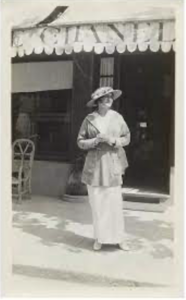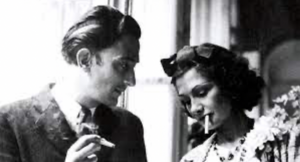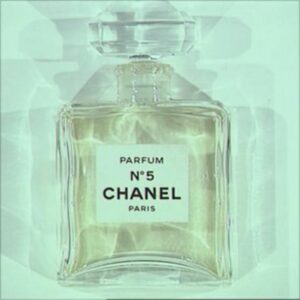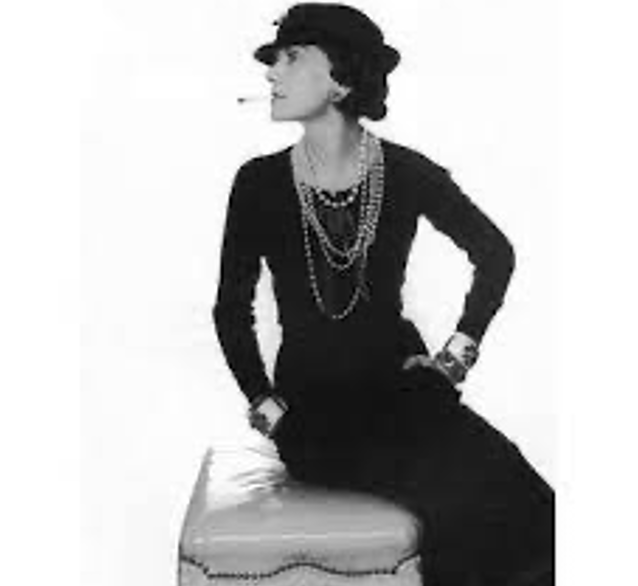Gabrielle “Coco” Chanel did not grow up with success in her pocket. A rough childhood led her to have nothing to her name and only have small accomplishments until she turned twenty-seven when she opened her first-ever store. Those small successes gave her the confidence she needed to change the game for women in the 1920s. Women were told to dress for the eyes of men and not for themselves; up until then, they wore clothing that was not ideal for daily life. Chanel had enough and set out her life to empower the modern woman at that time and find something that could be hers and hers alone.
Born in the countryside of Saumur, France, she was soon placed in a convent run by nuns in Aubazine, France after her mother died.1 Chanel grew up in a difficult environment where women had limited legal entitlements to assets, cash, or their children. Some even struggled with the right to their own bodies. Women wore constrictive apparel and corsets and lacked careers and financial independence. If a woman was born into a rich family, her best shot for success in life involved potentially being married well, being a performer on stage, or engaging in extramarital affairs with rich men. Women at the time had no accomplishments or properties to their name. Nothing was their own.
Even though her six years spent at the convent were not ideal, she learned routine, regimen, and how to work for what she earned. Living with the nuns was a blessing in disguise because this is where she learned how to sew. She and her sister whom she was also an orphan with, used their skills to become seamstresses once they were old enough to live on their own. They did what they needed to, to get by, but it was not fulfilling her need and want for money and independence. 2
Chanel yearned for something to be hers. She never had her own things, due to her living conditions. Being a hard worker was already engraved in her system and after leaving the nunnery, she became a singer for a short while, singing at “Le Grand Café,” a singing cafe in Moulins, France. where she rose to fame by her performance of the song “Qui qu’a vu Coco.” Her nickname, Coco, meaning “darling” in French, got its start from this.2 Here, military men would often come by. She was quite attractive and caught the eye of a man named Étienne Balsan. His family was rich from owning a company making textiles. He invited her to live at his estate with him in France. This is where her life would change for the better.4
She was constantly pampered with the newest dresses and jewelry, and Balsan probably thought he was getting more benefits from their relationship, but little did he know, he was funding the next greatest invention. She wasn’t working and she had a ton of free time on her hands. So she started to make hats. Their relationship could be seen as more of a transaction. She began wearing her hats, and some of Balsan’s famous friends would compliment her hats and ask where she got them. Selling them was now her hobby. This was the start of her designing career.5
Chanel moved to Paris, officially in her own place that was still owned by Balsan, in 1909. The following year she opened a hat shop called “Mode Chanel.” Finally, she had something to call her own and a way of getting away from poverty. But this was not enough for her. This gave her the confidence boost she needed to continue. She surged herself into what some might call ‘go mode.’ 6
After making hats for some time, she met the love of her life, Arthur Edward ‘Boy’ Capel, in Paris in 1910, who she would have an affair with for nine years. Capel pushed Chanel to grow her company and establish an outlet in Deauville in 1913.7 She specialized in selling sports attire for women made of jersey material, which was a rare fabric for women’s clothes at the time. Underwear for men was often made of jersey. Chanel is claimed to have created her first black dress for Suzanne Orlandi (1912), who was seen wearing a long, soft velvet black garment with a collar made of white.8

Capel urged Coco to grow a third time, and at the age of 32, Chanel launched her second store in Biarritz, France. Chanel had about 300 workers at this point and was already well-known.9 She debuted her first luxury collection here.

On December 22, 1919, a car accident claimed the life of Boy Capel. While Chanel mourned his passing for a while, she was not broken by it. Instead, she ran forward. Paul Morand was given information by Chanel about an incident that occurred six months after Capel’s passing informing him that a Hindu man had paid her a visit. Someone she knew had left him a message for her, saying, “This person is living in a place of happiness.” She kept what he told her to herself and never revealed it to anyone else. She remarked to Morand, however, that “it was a secret that no one, other than Capel and I, could have known.”10 No one knows what the message said but, it is thought to have given her newfound confidence in her passion for life and for her career.
Still wanting more because she was never satisfied, she continued on in changing the way people looked at women. By 1921, she owned her own house and operated a string of boutiques in France.
To go along with the clothes and hats she was creating for women, she wanted to create a scent that went along with her idea of a modern woman. It was uncommon for designers to have both perfume and articles of clothing. Chanel was notoriously known for smelling clean. She noticed as she worked alongside other women, they smelled of body odor and unpleasant smells. Her goal for her idea was to impose freshness. Her memory of the scent of soap and newly cleansed skin persisted for years after the convent. She could not make the perfume on her own, so her next step in creating her legendary scent was finding a perfumer up to the task. Frederic Malle, a perfume editor and professional “nose” says, “In those days the only way to create fresh fragrances was to use citrus such as lemon, bergamot, and orange. These things are very fresh and very charming but they don’t last on the skin.” These scents were already put together and made. This is what made all the fragrances at the time smell the same and usually of only one flower. Aldehydes, as they called them, were very potent and scared off a lot of perfumers.11
While on vacation, she met Ernest Beaux who was the only one up for Chanel’s challenge of making a complex perfume. He spent several months developing a fresh scent, but in the end, he produced ten samples and gave them to Chanel. The samples had numbers ranging from 1 to 5 and 20 to 24. She chose option five. The mixture is rumored to be the outcome of a lab error. An amount of aldehyde that had never been used before had been added by Beaux’s assistant. She was able to reconcile her upbringing in a convent with her rich lifestyle of being a mistress in this scent. The jasmine, rose, sandalwood, and vanilla-infused fragrance was an instant hit, in part because of Coco’s clever marketing strategies for the modern woman. She chose to scatter the perfume about the dining room table after inviting Beaux and his friends to a well-known upscale restaurant to celebrate the creation. Every woman who passed by paused and enquired about the scent they smelled and asked how they could get it. This was the turning point in Chanel’s mind that made her realize that her scent was going to be a groundbreaking perfume. Anyone in the public that day smelled Chanel No. 5. And those who smelled it, were absolutely halted in their tracks.12 Consumers smelled something for the first time at that very moment, marking an important turning point in perfume history. Chanel No.5 needed no introduction and no advertisement. Everyone wanted it.

Chanel had made it and this was her big break. Every woman knew who she was after the release date of Chanel No. 5 on May 5, 1921. She was at the top of her game and her name meant a lot. Her past no longer defined her, leaving her the world at her feet. She had the confidence to keep building her fashion empire.
She was already at the top. Her “rags to riches” story was now complete.
She had already led the fashion industry by introducing wide-leg pants and loose tops that were more functional for everyday life. She was not satisfied with just that, though. Chanel had aspirations to change the fashion game, especially for women. The creation of the Little Black Dress in 1926 came after her big breakthrough and changed the way the color black was worn from a color of mourning to a sophisticated piece of art. She left her imprint on society changing from tight corsets to looser fitted clothing that draped over a woman’s curves.
Women stayed with her throughout all of her groundbreaking shifts in the perfume and fashion worlds. Her story started off not heading in a good direction but with a little or a lot of hard work and being at the right place at the right time she made it to the top. The color black was intended to represent strength and freedom just as her perfume smelled of a woman and not flowers. Her name was made with the perfume and everything fell into place from there. Chanel did not forget about where she came from though. Her use of the ‘soapy smell’ came from her past growing up in the convent and constantly being around cleaning supplies they had to use. Making women have a name for themselves and a higher valued place in society was not her driving motivation but something she achieved all while making money and gaining independence. She had liberated ladies from the corset’s restrictions and inspired women of the younger generations that they too can do anything they put their minds t0o.
- “Chanel, Coco,” Funk & Wagnalls New World Encyclopedia, January 1, 2018, 1. ↵
- “The Story Behind Coco Chanel’s Name – Coco Chanel History,” L’Officiel USA, accessed May 15, 2023, https://www.lofficielusa.com/fashion/gabrielle-chanel-nickname-coco. ↵
- “The Story Behind Coco Chanel’s Name – Coco Chanel History,” L’Officiel USA, accessed May 15, 2023, https://www.lofficielusa.com/fashion/gabrielle-chanel-nickname-coco. ↵
- Andrew Radford, “History Of Chanel Perfume,” Viora London (website), February 21, 2020, https://vioralondon.com/history-of-chanel-perfume/. ↵
- CHANEL, “THE ALLURE OF CHANEL BY PAUL MORAND,” CHANEL, January 16, 2014, https://www.chanel.com/us/fashion/news/2014/01/allure-of-chanel.html. ↵
- “Secret Facts, History & Timeline Of COCO CHANEL: Life & Brand,” May 16, 2021, https://www.annieandre.com/history-coco-chanel-brand-life-timeline/. ↵
- Angela van Rose, “The Iconic Little Black Dress of Coco Chanel,” Angela van Rose (blog), July 12, 2018, https://www.angelavanrose.com/the-iconic-little-black-dress-of-coco-chanel/. ↵
- CHANEL, “THE ALLURE OF CHANEL BY PAUL MORAND,” CHANEL, January 16, 2014, https://www.chanel.com/us/fashion/news/2014/01/allure-of-chanel.html. ↵
- “Secret Facts, History & Timeline Of COCO CHANEL: Life & Brand,” May 16, 2021, https://www.annieandre.com/history-coco-chanel-brand-life-timeline/. ↵
- CHANEL, “THE ALLURE OF CHANEL BY PAUL MORAND,” CHANEL, January 16, 2014, https://www.chanel.com/us/fashion/news/2014/01/allure-of-chanel.html. ↵
- Andrew Radford, “History Of Chanel Perfume,” Viora London (website), February 21, 2020, https://vioralondon.com/history-of-chanel-perfume/. ↵
- “Chanel No 5: The Story behind the Classic Perfume,” BBC News, May 29, 2011, sec. World, https://www.bbc.com/news/world-13565155. ↵


